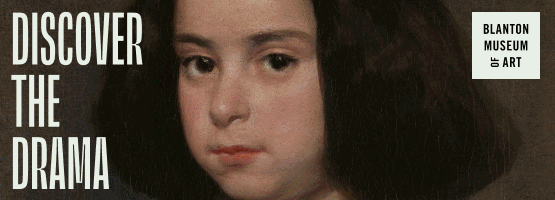Inspired by a gift from her grandson of one painting and four drawings, Janet Sobel’s early but short-lived career is now the subject of a compelling exhibition at the Menil Collection from Feb. 23 through Aug. 11. Credited with developing the “all-over” painting style that made Jackson Pollock and others famous in the 1940s and 50s, Sobel is being hailed as a pioneer of Abstract Expressionism, challenging existing narratives around mid-century modernism. In 1955, Pollock admitted that her paintings had made an impression on him.
Sobel was born Jennie Olechovsky in Ukraine in 1893. After her father was killed in one of the many pogroms against Jews, she immigrated with her mother and two siblings to Brooklyn in 1908. The mother of five children, she began painting at the age of 46, encouraged by her son, who gave her paint brushes and materials.
Natalie Dupêcher, associate curator at the Menil, organized the exhibition. “This show focuses on Sobel’s abstract work, but there is so much more to be discovered,” she said. “I hope this will inspire many more shows in the future.”
Five additional large paintings are also on display, borrowed from such major institutions as the Los Angeles County Museum of Art, the San Diego Museum of Art, and the Crystal Bridges Museum of American Art. A selection of works on paper, some mounted on board, reveals Sobel’s experiments with crayon, graphite, ink, gouache, enamel, and varnish. She made over 1,000 drawings during her lifetime, often embedding faces in the linear patterns and swirls that fill the picture plane with dense, interlocking shapes.
Sobel’s first solo show in 1944 at New York’s Puma Gallery was widely reviewed and caught the eye of Guggenheim, who called her “the best woman painter by far in America.” Sobel’s son Sol, an art student at the Art League in New York, shared her work with Surrealists André Breton and Max Ernst, both of whom visited her in her home. Sobel was also included in three group shows at the Brooklyn Museum in the 1940s.

1 ⁄7
Janet Sobel, Untitled, ca. 1946–48. Enamel and sand on board, 17 5/16 × 14 in. (43.9 × 35.6 cm). The Menil Collection, Houston, Gift of Leonard Sobel and Family. © Janet Sobel. Photo: James Craven

2 ⁄7
Janet Sobel, Untitled, ca. 1948. Crayon and paint on paper, 18 × 12 in. (45.7 × 30.5 cm). The Menil Collection, Houston, Gift of Leonard Sobel and Family. © Janet Sobel. Photo: Paul Hester

3⁄ 7
Janet Sobel, Untitled, mid 1940s. Graphite and crayon on paper, 12 × 9 in. (30.5 × 22.9 cm). The Menil Collection, Houston, Gift of Leonard Sobel and Family. © Janet Sobel. Photo: Paul Hester

4 ⁄7
Janet Sobel, Untitled, ca. 1948. Crayon on paper, 18 × 12 in. (45.7 × 30.5 cm). The Menil Collection, Houston, Gift of Leonard Sobel and Family. © Janet Sobel. Photo: Paul Hester

5 ⁄7
Janet Sobel, Heavenly Sympathy, ca. 1947. Oil on canvas, 54 1/2 × 34 1/2 in. (138.4 × 87.6 cm). Courtesy of Crystal Bridges Museum of American Art, Bentonville, Arkansas. © Janet Sobel. Photo: Edward C. Robinson III

6 ⁄7
Janet Sobel, Milky Way, 1945. Enamel on canvas, 44 7/8 × 29 7/8 in. (114 × 75.9 cm). The Museum of Modern Art, New York, Gift of the artist's family. © Janet Sobel. Photo: © The Museum of Modern Art/Licensed by SCALA / Art Resource, NY

7 ⁄7
Janet Sobel painting in her apartment in Brooklyn, ca. 1944. Courtesy of Gary Snyder Fine Art, NY
In 1961, influential New York art critic Clement Greenberg described Sobel’s technique as “the first really all-over effect that I had seen,” but he also referred paradoxically to Sobel’s work as “primitive” and that of a “housewife,” which hindered her legacy.
Another reason for Sobel’s faded prominence may be that she did not document her process. “As far as I have found, there are no Sobel notebooks or journals,” said Dupêcher. “But something that has been overstated is that she was unaware of New York’s rich culture. I found an article that said that she appreciated the pleasures of the theater, concerts, movies, and museums.”
In fact, Sobel self-identified as a Surrealist, and at one point is reputed to have said that “she heard a voice tell her she must paint.” She brought passion and enthusiasm to her practice, not overthinking it or limiting her materials. Sobel’s inclusion in several important museum shows in London, Paris, and Washington D.C. since 2016 seems to indicate that her story is still in the process of being told.
—DONNA TENNANT





